One of the many fun elements of researching my book has been seeking out yoked sweaters on eBay and in charity shops. I have learned a lot from these garments, which are often a hybrid of machine and hand-knitting, and thought I’d share a few of them with you today. I think I showed you the Shetland yoke jumper I’m wearing above on a previous occasion. It has a machine knitted body and a hand-knitted tree and star yoke with a characteristically back-buttoned placket; it fits me well, and I wear it frequently. I wanted to mention this jumper today because it is, in yoke terms, somewhat anomalous: the way the pattern repeats have been calculated means that the tree is centred both front and back. The back opening thus divides a tree in half:
I imagine this will seem an insignificant matter to some of you – after all, the motifs are still balanced and centred – but when you’ve looked at many Shetland yokes, and many patterns for Shetland yokes, it immediately appears odd. My friend Ella* was quick to spot its curious tree placement, and in almost every other example I’ve seen over the past six months or so, the star is centred, not the tree. (If the garment is a jumper, the star is always at front centre, and if a cardigan, there’s an extra star to balance the pattern, so the front opening is always flanked by stars.) So this yoke is a curiosity of which I am particuarly fond – I think its anomalous nature only endears it more to me.
Here is a non-anomalous, fairly standard Shetland tree and star yoke, that I found on eBay:
The body and sleeves have been machined, and the yoke, ribbing, and front bands have all been finished by hand. Its nicely finished – here you can see how, on the inside of the garment, the yoke has been steeked and cut; the yarn ends have been woven in; and have then felted down with wear.
And here’s another Shetland tree and star – a jumper this time:
Again, the star is centred, and the garment is a machine / hand-knitted hybrid. I am fond of this one, because it bears the lovely trademark of the Shetland Woollen Industries Association:
Back in the 1920s, the SWIA was established to protect native Shetland wool, and to promote and protect the products that were made from it. The trade mark guaranteed that the goods were genuine Shetland wool products, grown and produced in the Shetland islands. Sadly, this trade mark is just one of a litany of many never-wholly successful attempts to protect the term “Shetland”, in reference to wool and textiles, from appropriation and misuse. (You can read more about this issue in this 1952 parliamentary motion and debate and in Sarah Dearlove’s chapter in Shetland Textiles: 800 BC to the Present)
Here I am, spotting a couple of naughty rabbits about to chow down on what’s left of my leeks.
This jumper illustrates the evolution of the “Shetland” yoke (strictly speaking, its not made from “Shetland” wool, and neither is it made in Shetland) and despite the fact that its far too big for me I find it interesting because it demonstrates an important stage in yoke history as the garment became enabled for industrial mass production. These jumpers were – and are still – produced by Harley of Scotland on, as I understand it, some pretty innovative knitting machinery that enables the speedy creation of completely seamless and circular yoked garments.
Finally, here is a recent yoke find by which I was particularly excited:
I purchased this beautiful Norweigan yoke on eBay, from an Edinburgh seller who remarkably turned out to be a reader of this blog (hello, Amy!). It is one of many iterations of Unn Søiland Dale’s “Eskimo” design (please note that my use of that word simply reproduces the given name of the sweater: I am in no way endorsing the term’s unpleasant and inaccurate ethnographic connotations). As the tree and star yoke is to Shetland, so Dale’s yoke is to Norway:
(Images of Unn Søiland Dale’s Eskimogenser from Digitalt.Museum)
In its many forms, but always with with similar motifs and this characteristic colourway, Dale’s yoked sweater seems to have been in constant production in Norway since 1952, when it was first designed. This yoke is a true Norweigan icon (and is referenced as such in a recent pattern collection by Sandnes Garn)
And just like its Shetland counterparts, this commercially-produced Norweigan yoke is also a hybrid of machine and hand knitting, with careful finishing.
. . . and beautiful hand-knitting on the yoke.
Amy, your sweater has gone to a good home and I feel honoured to have it among my yoke collection!
All of these yokes involve some machine knitting, and all of them have been in some way instructive when thinking about the construction and creation of my own hybrid machine and hand-knit yoke, which is now nearing completion.
Ella machined the body, I blocked and seamed the body and sleeve pieces; picked up stitches for the yoke and, over the weekend, knitted my yoke on. It has been a really interesting process, and is the very last bit of knitting there is for my book. All of the patterns, including this one, are now complete – we are almost there!
So, I suppose I’d better get on and finish those front bands. . . .
*Ella has also been documenting her knitwear collection! Pop over here to see more yokes.

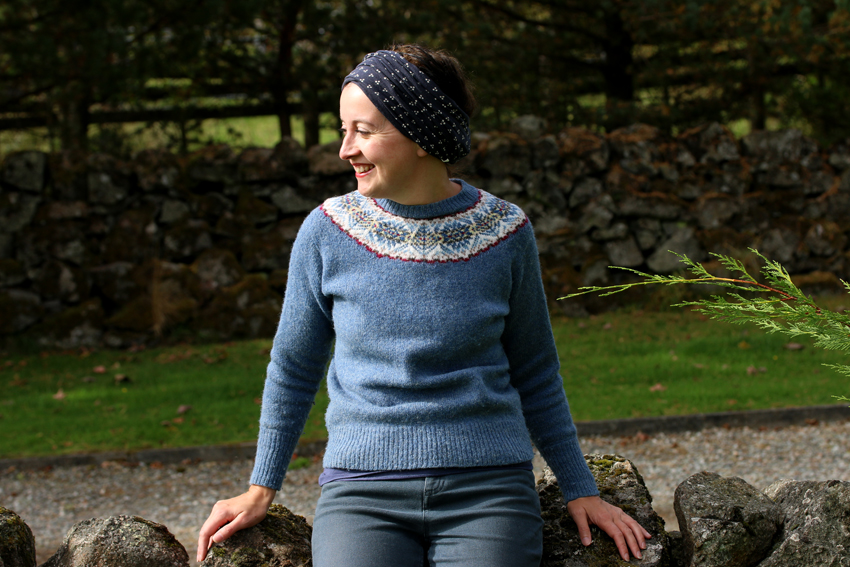
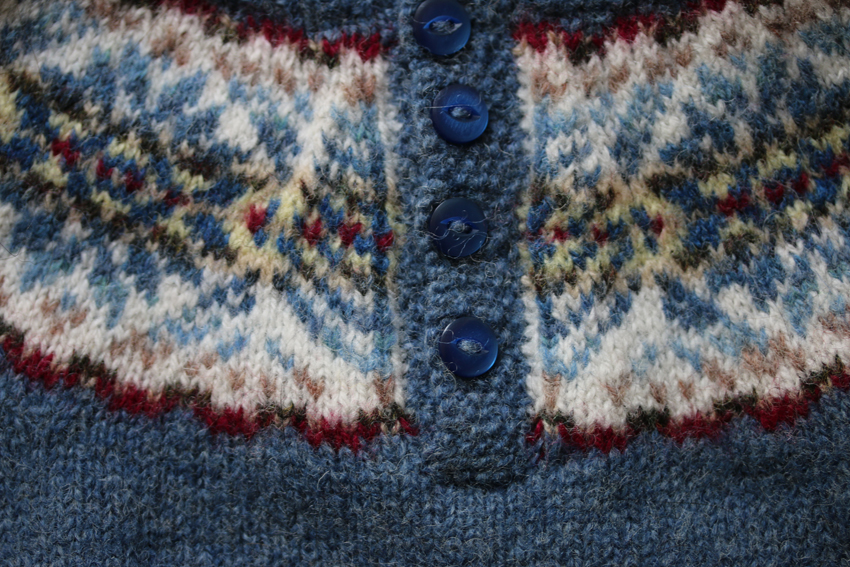
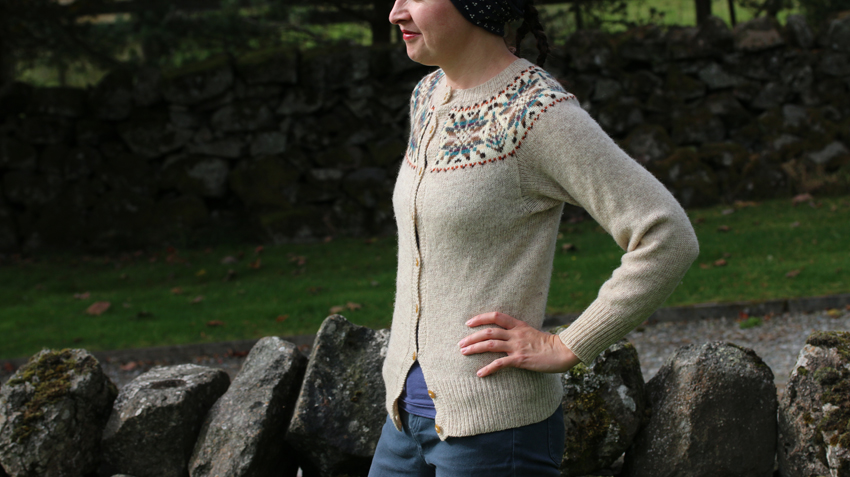
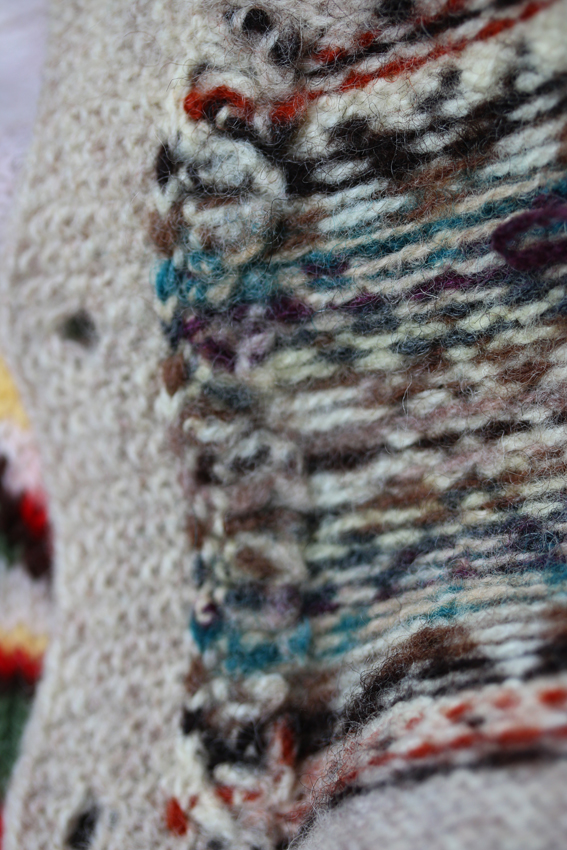
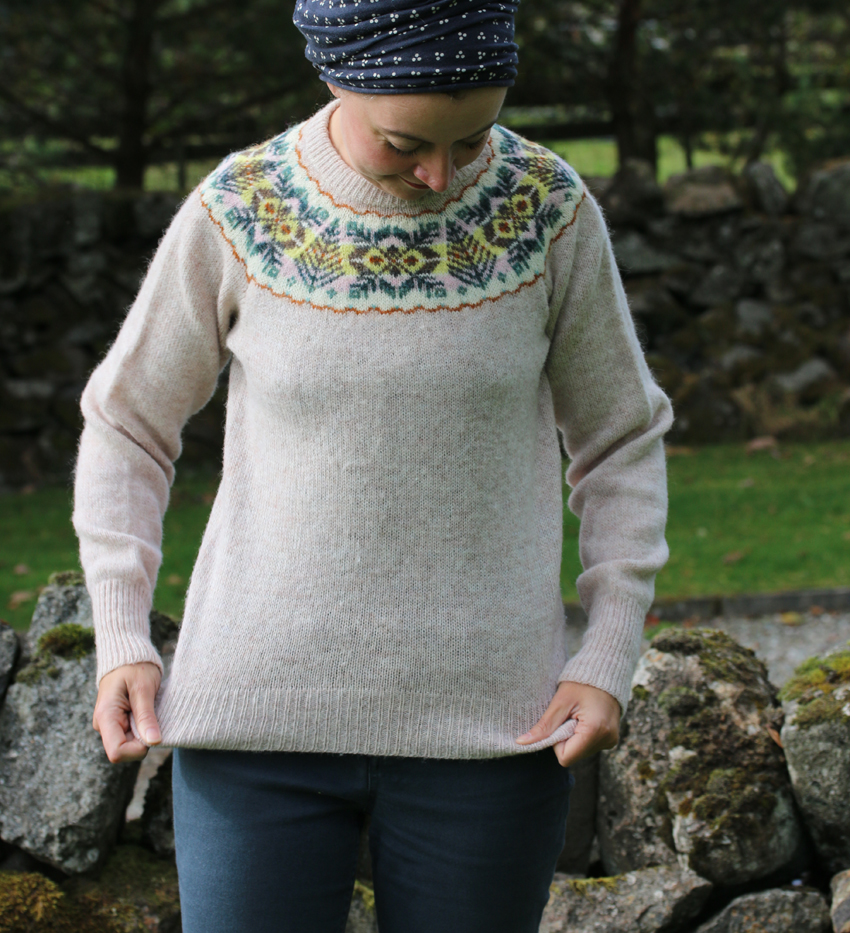

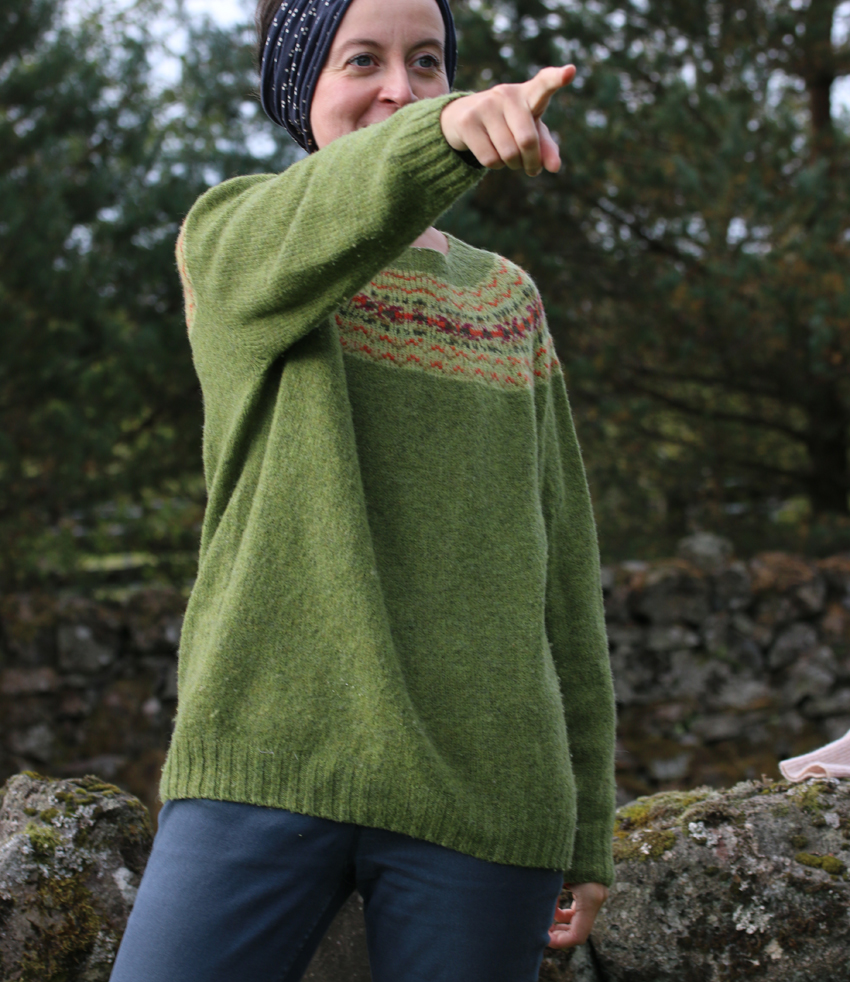
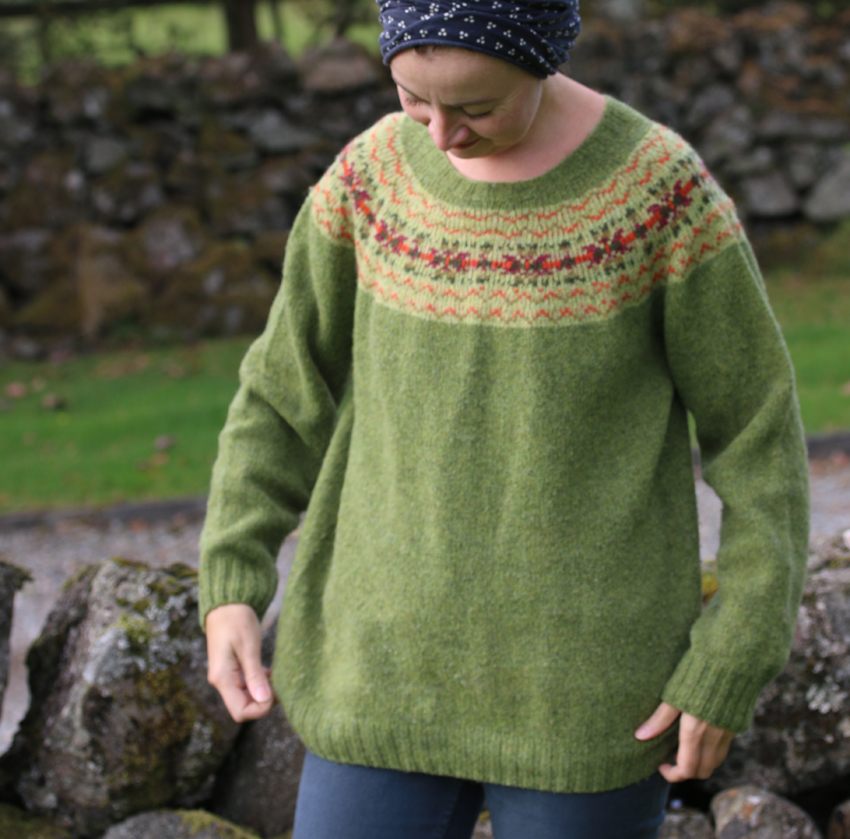


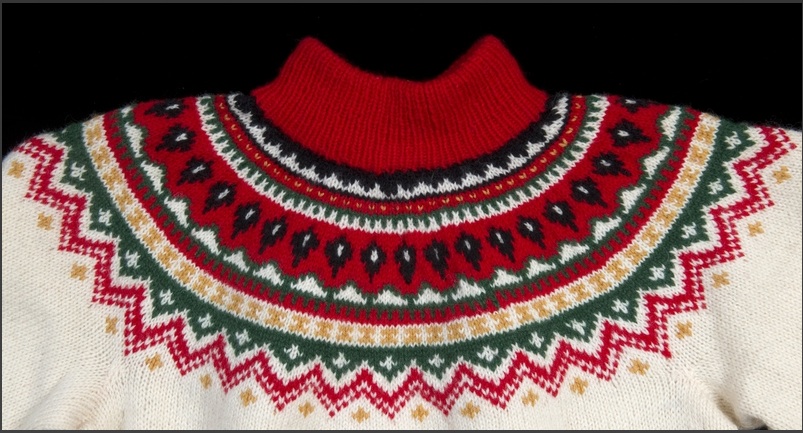
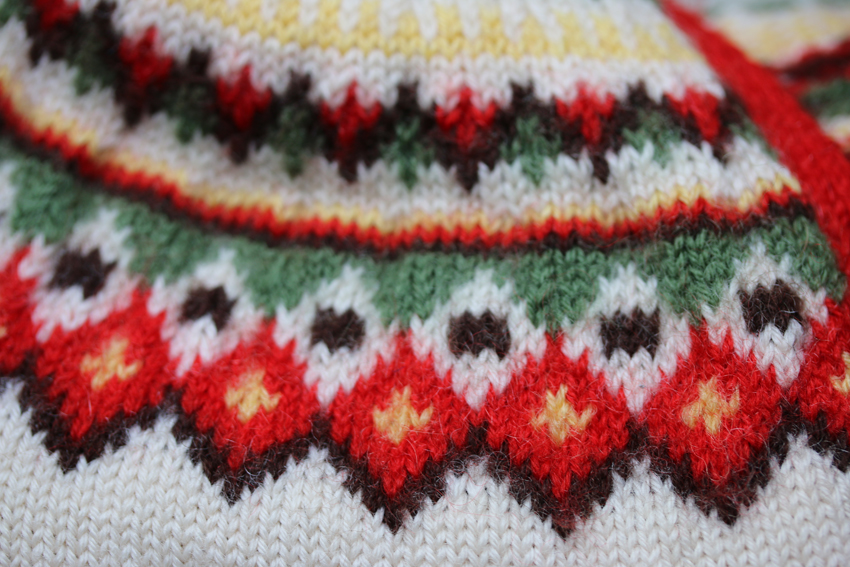
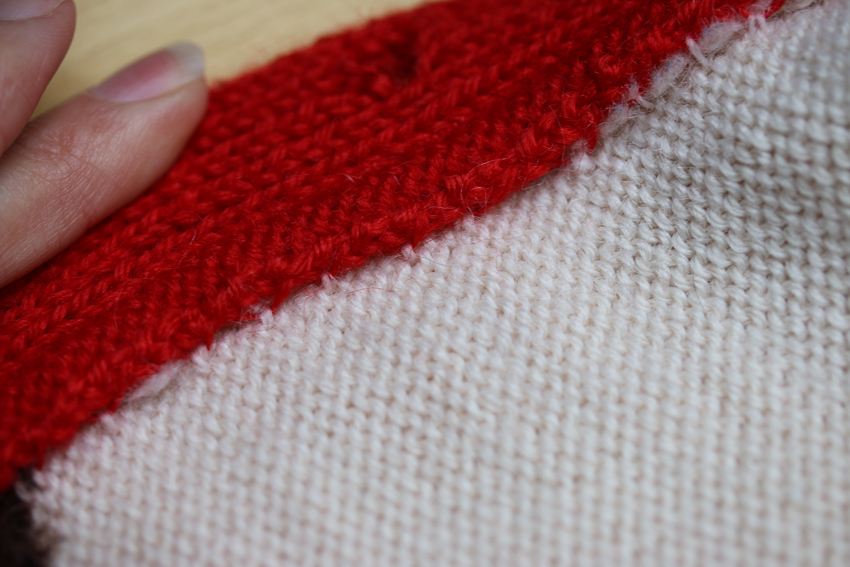
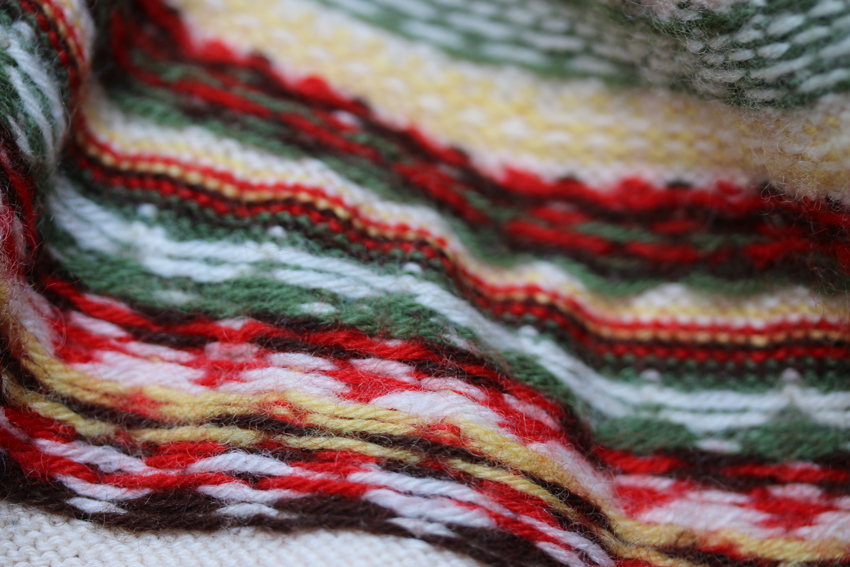
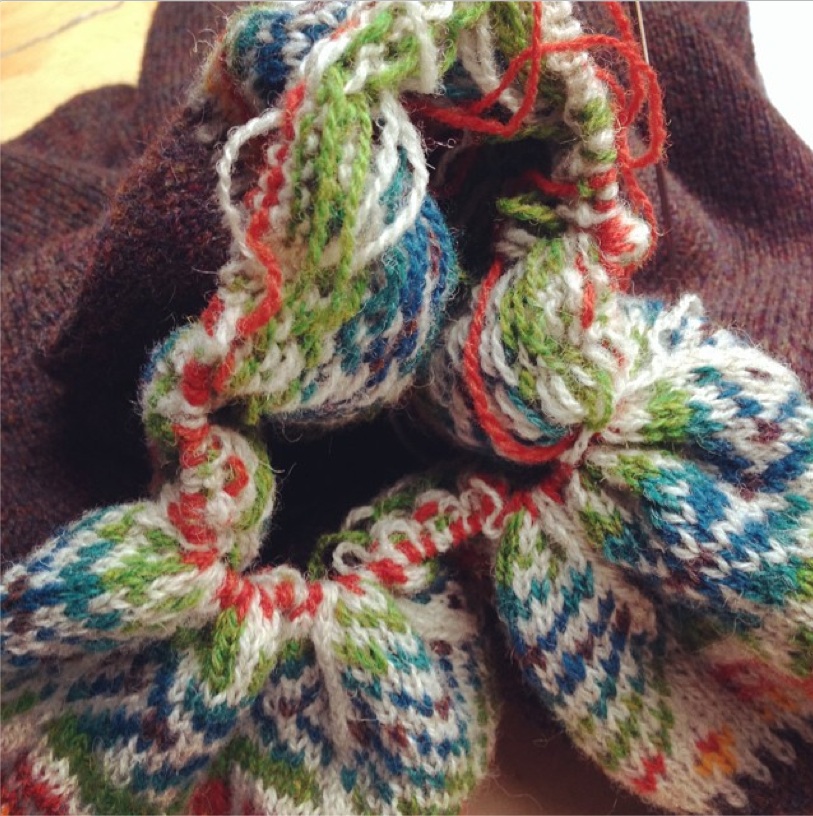
Lovely to see all the yokes you have collected Kate. Funnily enough I just bought a purple Harley of Scotland Yoked Cardigan in a charity shop when visiting St. Andrews this past summer. I have worn it almost everyday ever since I got it. How do you have any special care instructions for your treasures? Would you air or even wash them? Thanks so much for sharing your collection and knowledge. I love reading about your research projects and new designs.
I am looking forward to your new book.
Best wishes from Germany!
LikeLike
I’m not sure if anyone has shared this awful yoke joke with you. Years ago, the British Egg Board had a slogan: ‘Go to work on an egg’. One morning a man rang their switch and said said “My egg won’t start this morning”. The operator jokingly said “You might need to pull out the yoke”. He thanked her and hung up. Five minutes later he rang back and said “It’s all white now”. (Readers not old enough to remember manual choke systems in cars might not quite get all of this joke.)
LikeLike
I never, ever imagined how many sweaters are on EBay. After reading this I went there and just put in Nordic sweaters. There are pages and pages and pages of them. It is kiinda sad.
LikeLike
This is so exciting!! Your new book can’t come soon enough. We’re expecting a hard winter here and with Félix’s book and your book I should stay busy knitting the snow away.
A few months ago I downloaded patterns of sweaters (from Istex) using mostly Lopi yarn with such beautiful yokes.
LikeLike
Just received a J Jill flier and there is a fair-isle yoked sweater.. The yoke is definitely in this fall!
LikeLike
Thank you for this post with all new information. I am trying to write in a readable english, but I do make mistakes,sorry.
I am looking for your new book and reading about the hybrid yoke I had a schok… I hate knitting maschines! One of the reasons I like your blog and designs is the great respect for hand made (without taking the hands over a maschine) you show. I have learned so much about it here. But knitting maschines…I can understand its use for commercial purposes, selling a knitted product in big scale and promote the national wool industry ( like Shetland). As a private knitter however, I do not want to take part in a world where speed and less effort are first values. Instead, my admiration gets toward people, special to women in the past, which invested time to produce something with dedication and care, taking the whole process, overcoming also its tedious part. Hand knitting means for me love work, offering something very personal to a dear person, also to oneself. Some instead, see hand made as a primitive way of working, something that one was forced to do before modern industry came to save the humanity. I hoppe you do not become a knitting maschine designer. Of course I would continue to admire it, although stopping knitting them. Excuse me, I do not offend your work nor your taste, or those that like maschine knitting. I feel there is place here for different ways of thinking and about knitting. Best regards
Rita
LikeLike
Hello Rita!
I imagine this pattern will be my only foray into hyrbrid machine /hand knitting design. Because these garments have been so important to history of knitting, particularly in Shetland, I wanted to include one in my yoke book. But I have no plans at all to move into machine-knit design!
LikeLike
Thank you for tranquilizing me, then I know that this here is my treasure place in Internet. Many greetings!
LikeLike
Love yoke sweaters & I very much look forward to your new book. I know the green is machine knitted but that’s my favourite.
LikeLike
I love the tree and star pattern, but all the yoke designs are fabulous. One of the best parts of your blog is reading about different styles of knitting, and how you explore the history of crafts and textiles. I has never thought about knitting, other than making myself a garment, but you have opened up a whole new world of ideas etc., I have knitted your Puffin sweater (mt first yoke), and am looking forward to the new book in November. Long may you continue to share your knowledge and enthusiasm with us.
LikeLike
Hi, it’s Juliet from Harley of Scotland here (studied textiles at Grays), thanks for featuring our yoke. Great site and good luck with your book I’ll look out for it.
LikeLike
What fun, searching out yoked sweaters on ebay! I too loved the pic of the girls in their cardis. My mum is from Aberdeen and moved to London at 21 but I have always kept up with my Scottish heritage, having joined in knitting with my mum since I was about 5 years old. I visited Shetland last year with some of my knitting group and we watched yokes being knitted on circular machines in Jamieson’s spinning mill in Sandness. Fascinating for those of us who have always done it by hand.
I also have a fabulously thick and warm brown cardigan in Lopi wool, knitted by my mum a few years ago, then her friend liked it so much that she copied it, then it was too big for her, so she gave it to me – that means I have two cardigans (well, almost jackets they are so thick) exactly the same!!
I haven’t knitted a yoked jumper myself for years and years, so maybe this little bit of inspiration will entice me to do another one …..
LikeLike
Carol, I’ve also been lucky enough to have a tour of a good mill (Johnstons of Elgin). I highly recommend touring mills to any curious knitter. The tour I had left me impressed with how all the expensive machines imitate what we do by hand, and came from it. There is in my opinion, very little new that sprung from the machines themselves. There are more similarities to hand knitting than I ever imagined in every step, even though each sweater passes through about two dozen different skilled workers before getting boxed. I’m glad Kate talked about the machine + hand knit sweaters. After she said it, it made perfect sense!
LikeLike
Yes, Holly, I agree – nothing new from the machines. I have tried machine knitting in the past, but, for me, like most of us knitters, the joy is in handling the materials, working the stitches, watching the pattern develop and just feeling the contemplative, calming nature of handknitting. The machine, which may still be in the loft (?!) was given to me by someone else who had tried it and gone back to handknitting. No contest!
LikeLike
Back in the 1980’s I was in my machine knitting phase–I made many custom-knit designs for my customers (all one-of-a-kind). Then I added my sporty Yokes. My hybrid was to machine knit the yoke, “fit” it over the top of a sweatshirt (not sure what they are called in your part of the world), sew it in place and cut/remove the neck & shoulder portion of the sweatshirt. Some customers also wanted matching cuffs for the sleeves and even the cuffs for matching pants! Sadly, I don’t know how many I made, nor do I have any pics of them. Ahhh, the 80’s….
Love following you,
Polly
LikeLike
Polly, these sound absolutely amazing!
LikeLike
Your collection of yokes are all so wonderful! As always, I’ve learned a ton. Thanks so much for sharing your knowledge with us.
LikeLike
What fun looking at all the variations! My fave is the first one but that green one from Harley called my name also………just because it is GREEN :) And Ella’s collection? She needs help wearing them and I did volunteer but………….
LikeLike
Ok, so Yokes will go on my Christmas wish list, not the birthday one!
LikeLike
Ohemgee, I have a famous sweater! I’m so excited and glad it’s gone to a good home, the knitting world is a weirdly small place!
LikeLike
Interesting post, but I’m getting impatient! Did I miss mention of the book release date?
LikeLike
we will be going to print in November
LikeLike
Good to know. I’m going to have to find something else to distract myself with for the time being.
LikeLike
Yippee! Yokes on the horizon!
LikeLike
Interesting blog but your pictures just seem to confirm my suspicion that having a ‘neat’ upper body is necessary for yoked sweaters. PS knitting your Warriston and enjoying in immensely – more of that ilk would be grand!
LikeLike
Jo, sadly I am indeed short, narrow of shoulder and meagre of chest – but I have designed patterns in my book for bust sizes up to 52 ins, and there are also many different kinds of yoke pattern – cables, beads, texture etc – with different kinds of neckline – hopefully there will be one that appeals to you.
I also wondered whether you had come across these yokes, looking fabulous on fabulous women who, unlike me actually have boobs and shoulders?
http://knitty.com/ISSUEw12/PATTidunn.php
http://www.ravelry.com/patterns/library/plum-rondo-a-la-turk
LikeLike
Thanks Kate – I look enviously at your ‘meagre’ chest and down at my all too generous one and believed that I really could not wear a yoke without looking ridiculous: your links have proven that Yes I Can!!! Might give one a whirl now. I have loved your progress reports on your book and look forward to seeing it in all its glory,
Clara
LikeLike
Eagerly awaiting the arrival of your new book. Just wondering will the patterns be machine / hand-knitted hybrids?
LikeLike
Hi Mary, no – there are 11 patterns in the book, and just one of these is a machine / hand-knit hybrid – I really wanted to include one! But the other 10 yokes are all hand-knits
LikeLike
And if I have no knitting machine…?
I probably will be able to slog through the stocking stitch myself, if I so choose, right? I mean, yes, I can, but you will have instructions, non?
LikeLike
Hi Max, there’s just the one pattern, with the suggestion that you can machine knit the body & sleeves *if you want to* – there are also full instructions for knitting the complete garment by hand
LikeLike
There’s my question answered! Thanks for including a hybrid. I don’t knit by machine myself, but appreciate a look at what is certainly part of the commercial history of yoked sweaters.
LikeLike
Ahh, Kate, your blog is always, always, a source of such pleasure and inspiration, intellectual and creative stimulation and last but not least true civility and humanity. Thank you from a devoted reader.
LikeLike
These are just all so beautiful, I know right now a yoke is way beyond my knitting skills however your blog always inspires and makes me dream of one day when I can.
I just can’t wait to read your book (and drool over all the lovely pictures)
LikeLike
I can’t wait until your book comes out. I love the Eskimo sweater and it’s on my to-do list. Thanks for being an inspiration.
LikeLike
I really love the photo of the children all wearing wool sweaters. My own children grew up doing the same, but I think, sadly, that real (non-superwash) wool-wearing is not so much a part of North American culture any more, even here in Canada.
LikeLike
Another beautiful post! Thank you so much. Between you and Ella I’m having a lovely time!
We were in Shetland and the Highlands last May and I acheto return!
When will the new book on yokes be available?
LikeLike
I love seeing all these yoke sweaters! They are fun to look at and to see all the little creative twists and turns that designers have used over the years.
The word Eskimo means someone who eats raw fish. I live in a village in Alaska that is “Eskimo.” They are mostly Yupik and Inupaiq. They use the term Eskimo as well and it is not viewed as a horrible word in this village.
LikeLike
I wonder where Kate heard that “Eskimo” is an insulting term? Thanks, Nancy, for clearing things up.
LikeLike
Perhaps what was intended here was to clarify that not all aboriginal peoples who live in the arctic region would appreciate to be called Eskimo or have a craft associated with the name. Here in Canada calling an Inuk an Eskimo is considered a faux pas because (1)many do see the name as a pejorative and (2)because they are a distinct group of aboriginal individuals (i.e., distinct from Yupik and Inupaiq who do not, as Nancy suggests, necessarily object to the term). All this to say, for some aboriginal people, using the word Eskimo does, in fact, reflect a certain degree of cultural insensitivity. Not sure if this bit of info has helped or hindered and please, by all means, feel free to delete. :)
LikeLike
I am sure it is a mix bag using the term Eskimo but in my region of rural Alaska on the coast here it is not an issue. Yes they do us the term Yupik and Inupiaq (this spelling varies too)
as well.
LikeLike
What a treat this entry is, given, of course, that your whole blog is always a treat! The yoked jumpers and cardigans have fascinated me since I was a little girl many, many moons ago. I have never knitted one, although the day is drawing nearer when I will, but I have read lots of patterns. I remain totally convinced of the importance to talk about and record the most fragile of clothing that knitting often represents along with its historical and social story. So well done!
LikeLike
Fabulous links to wander about in, thanks. So excited for this new book of yours. Yokes, yokes, yokes, yokes!!!!
LikeLike
You’ve been really immersed in the Yokes for some time, I feel an epic collection of your own about to take flight and I’m really excited ! Also, how fun to find Ella’s designs & blog to follow & thanks for the link !
LikeLike
my sentiments, exactly!
LikeLike
I love to read your informative posts. Thank your for sharing! Your new book is going to be wonderful!
LikeLike
This is very interesting, as always. Thank you.
LikeLike
I just love all those yokes! Recently my mother gave me a box of yarn she received from an elderly woman at church and in it to my surprise was a cardigan sweater kit, complete with a machine knitted yoke and absolutely no directions! Hahaha what an adventure I have ahead of me!
LikeLike